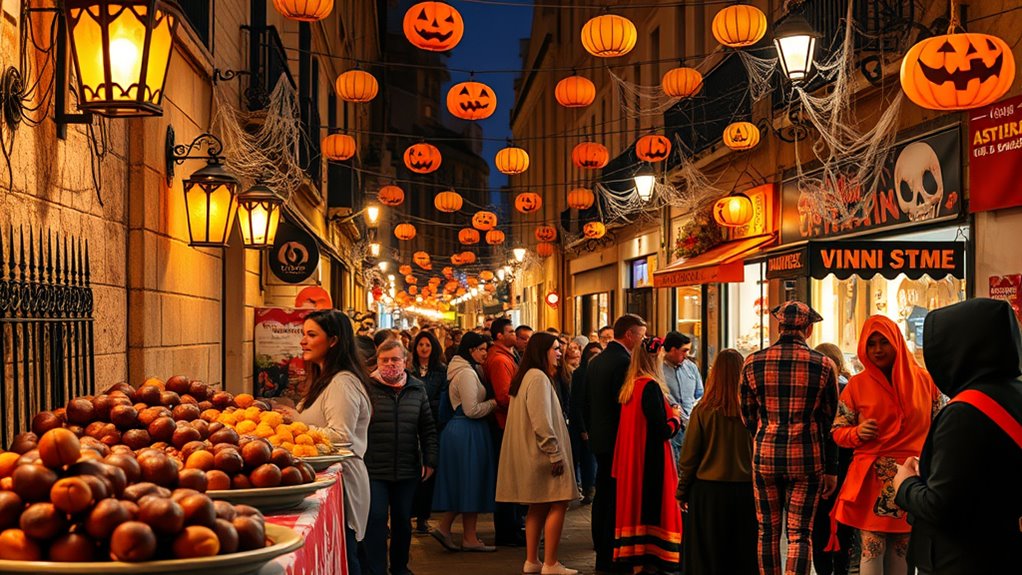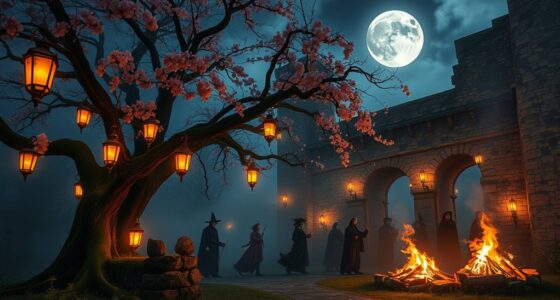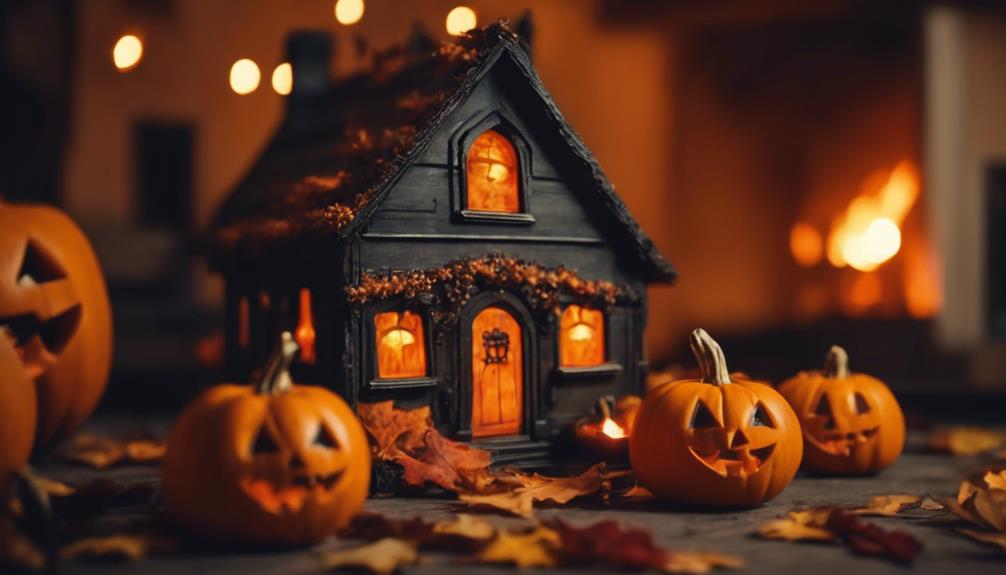In Spain, Castanyada centers on honoring ancestors with traditional foods like roasted chestnuts and panellets, emphasizing family, remembrance, and cultural roots. Halloween, imported from North America, is more playful, featuring costumes, spooky decorations, and sweets, especially among younger people. While Castanyada reflects deep tradition and seasonal change, Halloween celebrates fun and imagination. Interested in how these festivals blend tradition with modern influences? Keep exploring to see how Spain balances its rich cultural heritage with contemporary festivities.
Key Takeaways
- Castanyada is a traditional Catalan festival celebrating remembrance, family, and seasonal harvest with foods like chestnuts and panellets.
- Halloween, imported from North America, emphasizes costumes, decorations, and fun activities centered around sweets and spooky themes.
- Castanyada has deep cultural and historical significance, focusing on honoring ancestors and cultural identity.
- Halloween is more modern and entertainment-driven, highlighting social gatherings, costumes, and playful fun.
- Both festivals reflect Spain’s evolving culture, blending tradition with contemporary influences during October.

As October approaches, many people in Spain find themselves caught between celebrating the traditional Castanyada and embracing the modern festivities of Halloween. You might notice local markets filling with roasted chestnuts, sweet potatoes, and panellets—small marzipan confections topped with pine nuts. These traditional foods hold deep cultural significance, serving as a way to honor ancestors and mark the changing seasons. Castanyada, rooted in Catalonia and other regions, is more than just a food festival; it’s a celebration of heritage that emphasizes family gatherings and remembering loved ones who have passed. The roasted chestnuts symbolize warmth and community, uniting people as they share these simple yet meaningful treats. The cultural significance of Castanyada is woven into Spain’s history, representing a link to the harvest and the cycle of life and death. It’s a time when the focus remains on tradition, family, and remembrance, often accompanied by singing, storytelling, and visits to cemeteries. Additionally, the emphasis on color and symbolism during Castanyada enhances its role as a cultural tradition that connects communities through shared customs.
Meanwhile, Halloween, imported from North America, emphasizes a different kind of celebration. It’s more about costumes, spooky decorations, and themed parties. You might see children dressed as ghosts, witches, or superheroes, going door-to-door for candy. While it’s a relatively recent addition to Spanish festivities, Halloween’s popularity has grown rapidly, especially among younger generations *keen* to participate in the fun and thrill of the spooky season. Its appeal lies in the playful and imaginative aspects, making it a lively contrast to the solemnity of Castanyada. Unlike the traditional foods of the former, Halloween’s treats are often candy and sweets that emphasize indulgence and entertainment rather than cultural symbolism.
Despite these differences, both celebrations reflect Spain’s evolving cultural landscape. You can participate in a family gathering around traditional foods during Castanyada, sharing stories and honoring history. Or, you might join friends at a costume party, reveling in costumes and sweets. The contrast isn’t just in the foods or festivities but also in what they symbolize: one rooted in remembrance and cultural identity, the other in fun, innovation, and global influence. Whichever you choose to embrace, this season offers a rich tapestry of traditions that highlight Spain’s ability to honor its past while welcoming new influences. As October unfolds, you’re invited to appreciate both, understanding how each celebration enriches the cultural fabric of Spain.
Frequently Asked Questions
How Do Children Typically Celebrate Castanyada?
When celebrating Castanyada, you typically see children dressed in traditional costumes, adding a festive touch to the event. They enjoy walking around, singing traditional songs, and sharing roasted chestnuts with friends and family. The lively atmosphere is filled with joy and cultural pride. You might also notice them carrying paper lanterns or participating in local festivities, making the celebration a memorable experience rooted in community and tradition.
What Are the Traditional Foods Eaten During Castanyada?
During Castanyada, you’ll enjoy traditional confectionery like roasted chestnuts, which are the star of festive gatherings. You might also indulge in panellets, small sweets made with marzipan and covered in pine nuts, and sweet potatoes. These treats create a warm, cozy atmosphere as families and friends come together to celebrate. The focus on these delicious foods helps preserve the cultural significance and adds to the festive spirit of the occasion.
How Has Halloween Influenced Spanish Culture?
You’ve probably noticed Halloween’s influence on Spanish culture through the trick-or-treating evolution, where kids now go door-to-door collecting candies more frequently. Costume popularity has soared, with many embracing spooky or fun outfits. This celebration’s growing presence has blended with local traditions, making Halloween a lively event. While still distinct from traditional festivals, Halloween’s impact encourages creativity and social gatherings, shaping modern Spanish festive customs.
Are There Regional Differences in How Castanyada Is Celebrated?
Think of the Castanyada celebration as a tapestry woven with regional variations and unique customs. In some areas, you might find lively street festivals with traditional songs, while others focus on family gatherings around chestnut stalls. These regional differences shape the celebration customs, making each locale’s festivities distinct. Your experience will vary depending on where you are, but the warmth and community spirit remain a constant thread throughout Spain.
How Do Schools Incorporate These Holidays Into Their Curriculum?
You’ll find that schools incorporate holidays like Castanyada and Halloween into their curriculum through cultural integration and educational activities. Teachers often organize themed lessons, storytelling, and crafts to help students understand each holiday’s significance. These activities promote cultural awareness, allowing you to experience traditions firsthand. By engaging students in such celebrations, schools foster respect for diverse customs, making holidays both fun and educational, enriching your overall learning experience.
Conclusion
As you experience both traditions, you’ll see how they’re like two sides of the same coin—one rooted in history, the other in modern fun. Castanyada warms your heart with its nostalgic flavors, while Halloween sparks your imagination with spooky excitement. Embracing both lets you feel the rich tapestry of Spanish culture, like a vibrant mosaic. Whether you prefer tradition or thrill, you’ll find that celebrating either leaves you with memories as sweet as a roasted chestnut.










